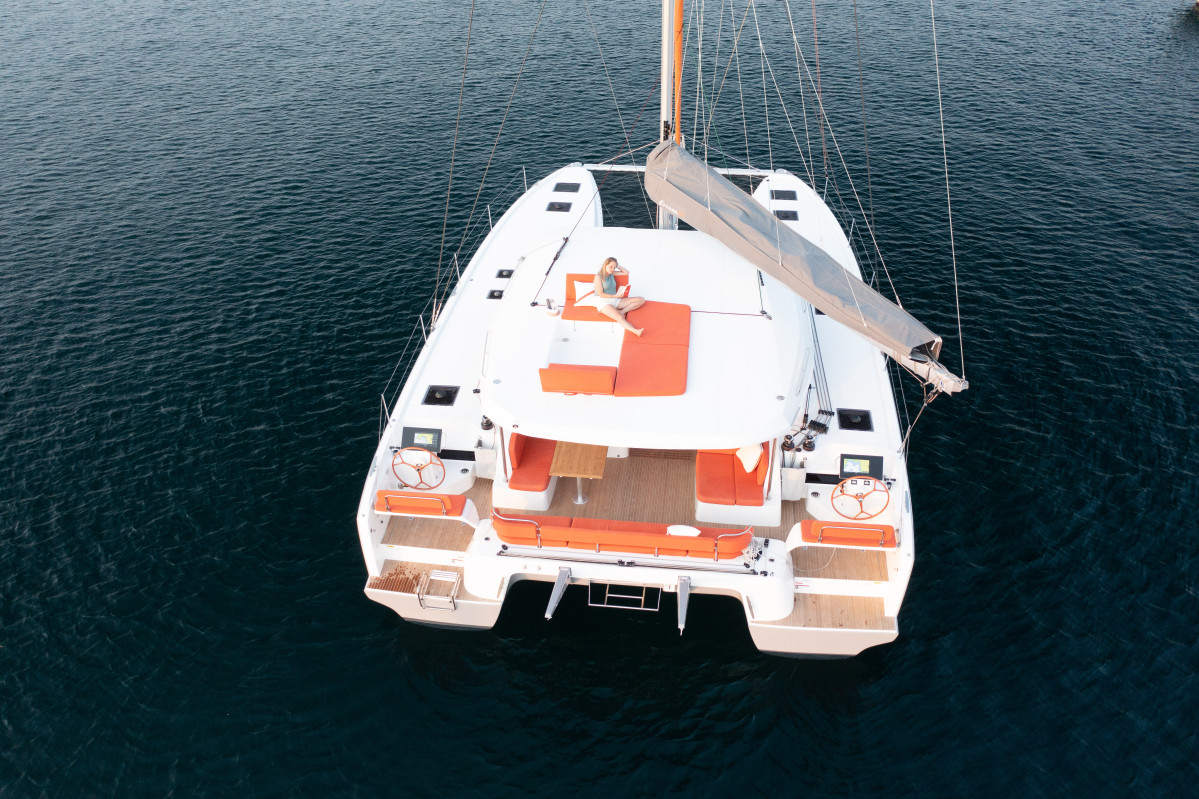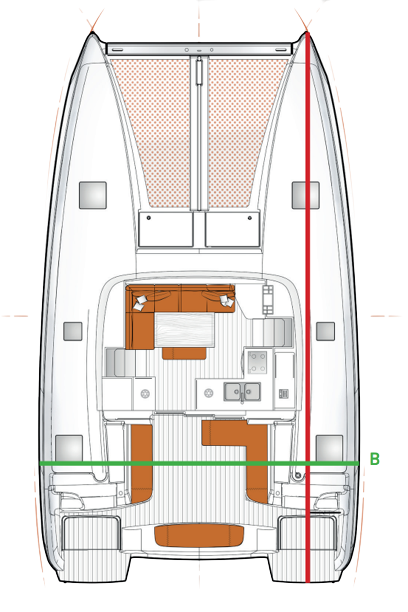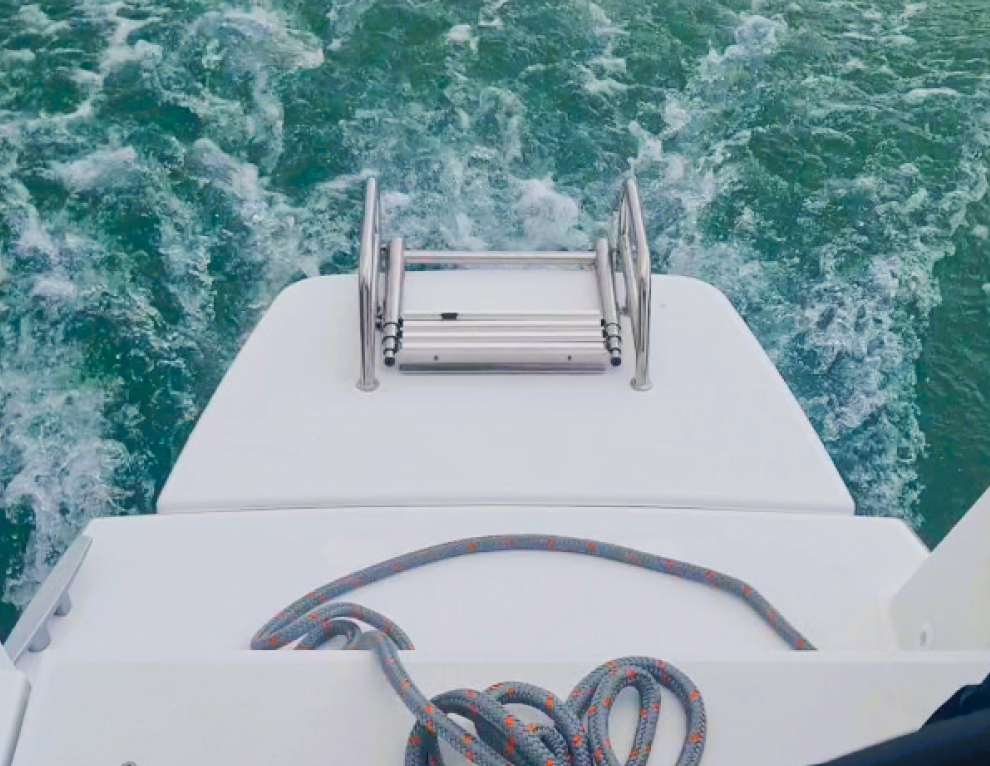AFT TRANSOMS

Once more, we would like your input so that, together, we can conceive an aspect of catamarans that is as practical as it is aesthetically pleasing, the result of numerous compromises: the aft transoms.

In the design of a catamaran, every centimeter counts, every shape, every component has an impact on the performance, the comfort, and the safety. It is in this spirit that today we explore the topic of aft transoms of Excess catamarans, which are among their more distinctive elements. Our objective is to initiate a discussion within the community of sailing enthusiasts to see what ideas might emerge and which creative solutions might be envisioned.
Why are our aft transoms short?
Short aft transoms on Excess catamarans are not the product of chance. They were carefully designed to optimize multiple aspects of our catamarans.
On our Excess 11 and Excess 14, a crucial decision was taken: to move the mast forward of the coachroof. This decision stems from multiple considerations, notably structural advantages, weight reduction, living space in the saloon, and improved performance, due to an increased sail area. Following this evolution, our product managers found themselves faced with a dilemma: to fix the aft transoms and shorten the nacelle, and thus the layout, or to move the mast further to conserve a spacious nacelle and long transoms, but in compromising our ratio of 1.5 for the nacelle/hull length overall (article on the boat’s performance by Bruno). Contrary to the option of moving the mast forward or reducing the length of the nacelle, we chose to place the mast in the optimal location, by moving the nacelle aft, without reducing it, to improve the entire cruising experience. This evolution then led to shorter transoms, a deliberate choice to optimize the handling, aesthetic design, and accessibility of the catamaran, all while maintaining a long nacelle moved aft.

If you have ever had the chance to sail aboard an Excess, you have probably noticed the short distance between the helm and the water’s surface. This configuration simplifies handling by offering the helmsman a clear view over the boat’s stern, while also facilitating access on board. Vincent, with Excess Delivery Services, demonstrates docking maneuvers for us in the Excess tutorial, with an ideal flow of movement via these aft transoms.
However, could they be extended?
Although short aft transoms present numerous advantages, it is a legitimate question to ask if they could be extended to meet other needs, notably space, water access while at anchor, or access to the tender.
At Excess, we have identified multiple systems to extend these transoms:
Make longer hulls: A simple option would consist of increasing the hull length. That would enable us to have more spacious transoms, but it would also increase the overall size of the boat, which would in turn lead to a cascade of additional costs and constraints for the user. In fact, that would mean a larger boat with an artificial forward placement of the mast!
Transom extensions in fiberglass: fiberglass transom extensions, like those used on the Excess 11 and 12, could be considered. They offer an economical solution for elongating the deck without affecting the architecture of the hulls, but they could affect the boat’s aesthetic design.

spaces below or alongside the transoms, to store marine equipment or even docking systems for the tender (inflatable swim platform).
Any suggestions from the Lab Community? Pencils ready!
Call for Ideas from the Express Community
We invite you to share your ideas, your experiences, and your reflections on this subject. How would you envision the extension of the aft transoms, and are you a fan of this idea? Do you have other solutions for making the aft transoms more welcoming, more practical, and more ergonomic without compromising the benefits of a long nacelle?



The transoms would have 3 modes as shown in the pictures:
1. Driving the boat from a standing position (transom raised with seat raised)
2. Driving the boat from a sitting position (transom raised with seat lowered)
3. Moored position (transom lowered)
Overall however, I think it’s great to see shorter transoms and more useful uses of the overall length as we all know boats and especially berthing are expensive to run!!!
We find the short transoms really ggod looking. I would have liked something to hold on to when going on/off the boat. second thing I would have changed is the swim lather which is centered, it should have been moved as far towards the center of the boat as possible, its kind of in the way going on/off
Regards
Andreas
However if you feel that the hull extension is not feasible another option could be a solution like on the HH44. The transoms are extended by an element that's folding up or down. In the down position it extends the transom, in the up position it serves as additional protection / enclosure of the aft helm station.
So it would add value in both positions.
on my 14#23 I am very happy with the transom as it is. It's easy to get ashore and access to the dingy is also ok if an extra line is available. Much more important to me would be a secure way of holding on to the railing when the cover is pulled over the helmseats.
It would also be great to have a solution for securing the helmseats, protected by a cover, in heavy seas. They move up and down a lot. We pull the cover over them to protect the helmseats from salt in bad weather.
Keep up the good work.
Rainer, SY Geronimo
The plus side of a wider transom is a comfortable space for my guests to put on flippers, snorkels etc before swimming and not to have to do this one person in sequence. Indeed a couple can be sat on the transom with feet in the water supervising children swimming.
It is also useful to inflate foiling wings or kites off a wider transom.
That said I wouldn’t want to add drag to the cat’s configuration or move the mast much further forwards than the 11.
Could I suggest a compromise where the transom is wider above the wetted surface then transitions to optimal below the water line?
Similar to how you grow cabin volume above the water line.
Cheers,
Tim